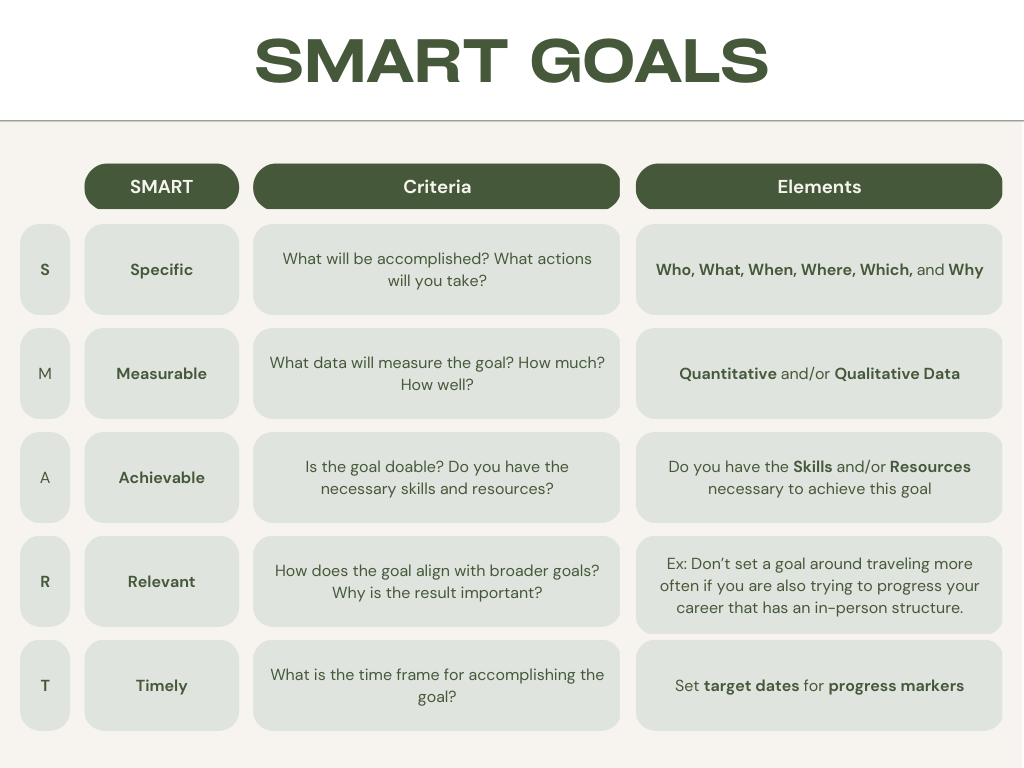
Applying Business Goal-Setting Strategies To New Year’s Resolutions
As marketers, we are no stranger to setting and executing goals for our clients and companies, but why is it so hard to do the same thing in our personal lives, like when it comes to New Year’s Resolutions? What if we applied those same strategies we use for business to our New Year’s Resolutions? I believe that, if it works to make businesses money, it can work for you too!
Setting Up A Goal Hierarchy
Before you start listing off all the different things you want to accomplish in the new year, you have to first zoom out and look at the big picture. Think about those long term goals you want to achieve and which medium or short-term goals can help you achieve them. It is just like when companies come up with a vision statement to mark the ultimate goal they are working towards. This process ensures that all other goals align with and keep in mind the vision, so that you don’t get sidetracked or work towards something that is counterproductive. So set up your vision statement by thinking about what you do, how you do it, and why you do it and build out your goal hierarchy from there.
Creating SMART Goals
For most, hearing the term: “SMART Goals” will bring you back to your freshman year Foundations of Business course and it’s probably a suppressed memory, but getting back to the basics is a great place to start with goal setting. As most of you have already guessed, SMART is an acronym and we use it to define goals that we are more likely to succeed at. If you truly want to commit to your resolutions, you have to spend the time to set thoughtful goals, otherwise you don’t have goals, you have dreams; so consider this criteria:

Not all aspects of SMART will be applicable to each goal, but they are all important to getting your planning and thoughts down. So even if you have a goal you can’t measure or bind to time, consider all the SMART parameters to understand your goal. Worst comes to worst you can always guesstimate.
You can download our SMART Goals Worksheet and Tracker by clicking here: 2023 Goal Setting
Tracking
As important as it is to have SMART goals, they mean nothing if you don’t actually follow through on the M component. As crazy as it sounds, the point of having measurable goals is for you to actually measure them. At work, you likely have a spreadsheet, timesheet, or software that you use to track your progress on projects, and if you are anything like me watching your progress bar go up is more satisfying than the completion of the project itself. There is a psychological basis to seeing your progress, because it makes us feel like things are working. With the mental challenge that comes with completing your goals being the most difficult challenge, anything you can do to relieve that strain can make the difference between success and failure. So create a tracker for the habits you want to implement, or take a photo in the same outfit everyday to measure your weight loss, or even make something as simple as a to-do list that you check off as you go.
The Pareto Principle
The Pareto Principle is also known as the 80/20 rule, where 80% of the results come from 20% of the efforts. You are most likely familiar with this concept in sales, where 80% of sales come from 20% of customers. Companies spend much more time and money keeping those loyal customers than they do acquiring new customers due to ROI. So when you go to execute your resolutions, focus your time, money, and energy on the tasks that have the largest pay-off rather than embodying a completionist mentality. It may be satisfying to check everything off a list, but oftentimes, the few harder tasks are going to give better results than the 30 easier tasks.
Adapting
You may find through tracking or major life changes that you have to adapt your goals over time. You may be progressing at a slower or faster pace than you anticipated, or maybe you no longer have a need for a certain goal. It is perfectly normal, and encouraged to revisit your goals. Many companies have to develop a Plan B, and C, and D before they reach their desired outcomes, and the same can be said for you and your goals. You know what they say: it’s all about the journey, not the destination.
Want to learn more about SMART Goals? Check out this guide here from Forbes.
